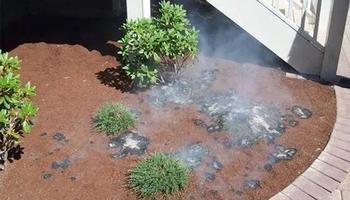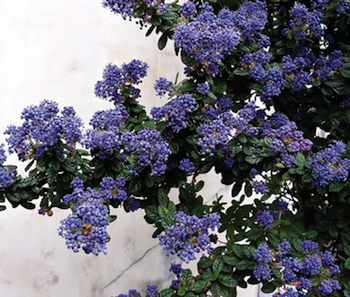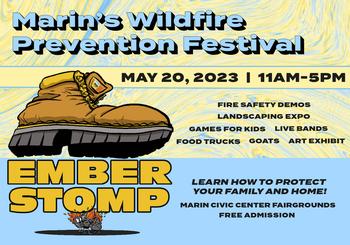Prepare your garden for wildfire with appropriate mulch, native plants, and careful pruning
-
Julie McMillan
-
Contrary to popular belief, this year’s enormous atmospheric rivers and rainfall totals will not lower our risk for wildfire. Instead, more rain produces more vegetation, which means more fuel to burn. The largest wildfires in California’s history show strong correlations between above-average rainfall and above-average vegetation growth. The active wildfire seasons of 2015, 2017, 2018, and 2020 were generally preceded by above-average precipitation.
Knowing what may happen given all our rain, now is the time to get better prepared for wildfire:
- Choose appropriate mulch.
- Install native plants.
- Carefully prune your shrubs and trees to reduce fuel.
To see UC Marin Master Gardener demonstrations and displays about these topics and many other exhibits, please join us Saturday, May 20, at Ember Stomp!, a free wildfire prevention festival at the Marin Civic Center Fairgrounds.
Mulch is a material placed on top of the soil to protect and enhance your garden’s appearance. It mimics the natural environment found in forests and benefits water retention, weed inhibition, soil erosion, and temperature. These qualities can help reduce fuel risk in fire-prone areas. But adding mulch may also introduce new combustible material into your landscape, so pay attention to the type, location, and amount of mulch you use. Gorilla hair mulch (or shredded western cedar) is highly flammable and should be avoided. Photo: Fire Safe Marin.
Gorilla hair mulch (or shredded western cedar) is highly flammable and should be avoided. Photo: Fire Safe Marin.Non-combustible or inorganic mulch such as rock and gravel pose no fire risk and may help deflect a fire. Use non-combustible mulch in Zone 0, the area 0-5’ from your home. Beyond Zone 0, composted wood chips are the least hazardous and least flammable organic mulch. Use composted wood chips 5’ and further from your home, applied 2” deep. Never use the most hazardous and flammable mulches: shredded western red cedar (known as “gorilla hair”), shredded rubber, and pine needles.
Native plants are an excellent choice for a fire-smart landscape. Drought-tolerant native plants often maintain a high internal water content without needing much water. Native trees may restrict the growth of more volatile invasive species. Natives also support insects, butterflies, pollinators, and other wildlife. California lilac (Ceanothus spp.) is a native plant that attracts bees. Photo: Gabriela Beres
California lilac (Ceanothus spp.) is a native plant that attracts bees. Photo: Gabriela BeresBeyond Zone 0, choose short natives that are compact, open-crown, and non-twiggy, such as the smaller currants (Ribes), small sage (Salvias), ground covers, and low-growing California lilac (Ceanothus) — bearing in mind horizontal and vertical spacing, especially beneath trees. Beyond 30’ from your home, you can plant larger, taller, and more robust trees and shrubs, such as Manzanitas, larger Ceanothus, Ribes, and other large shrubs.
Pruning removes all or parts of plant branches to make a plant smaller or more open and more fire safe. Overgrown, diseased, or dead material in plants or trees creates excess fuel that can feed a fire’s spread. Keeping plants and trees adequately trimmed and pruned reduces fuel load and creates more space between plants, but bad pruning increases the fuel load. Here are the steps to take:
- Remove dead, damaged, and diseased branches.
- Cut back vines and low-growing groundcovers to remove the build-up of dry stems and dead leaves.
- Cut back woody, twiggy, or overgrown shrubs that accumulate dry material.
- Thin and reduce tree canopies to remove twiggy growth, maintain separation between trees, and reduce overall fuel load (don’t cut the tops of your trees (called “tipping” or “heading”), which causes excessive branching, is unhealthy for the tree, and results in twiggy growth that can increase the fire hazard)
- To reduce the fire ladder, limb up trees 6-10’ from the ground (or for smaller trees, up to one-third of their height)
Consider hiring a professional tree trimmer if your tree or shrub is over 15’ high or near a power line.
To learn more about these and many other wildfire preparedness steps, please come to Ember Stomp!, a free wildfire prevention festival Saturday, May 20, from 11 am-5 pm at the Marin Civic Center Fairgrounds in San Rafael. There will be live music, children’s activities, and great food. https://firesafemarin.org/programs/wildfire-preparedness-festival/#gsc.tab=0 For more general information about fire-smart landscaping, please visit https://marinmg.ucanr.edu/BASICS/FIRESMARTLANDSCAPING/



